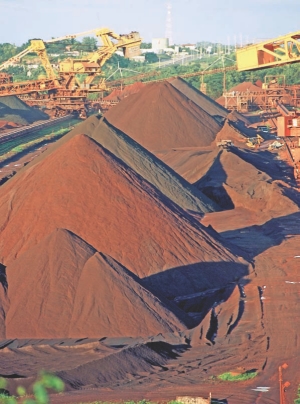With the growth of spot pricing for iron ore, it looks as if the existing system, based on a benchmark price set by annual negotiations between miners and steelmakers, is coming under increasing pressure. The largest iron ore miners are adopting different stances to deal with changes in the way prices are set.
Iron ore production was 1.6 billion tonnes in 2007, with the three largest iron ore miners, Vale (VALE-N), Rio Tinto (RTP-N, RIO-L) and BHP Billiton(BHP-N, BLT-L), together controlling 35% of the market.
The concentration in seaborne iron ore is even higher: Vale alone controls 36% of the world market, and the three companies together command a 69% market share. The pricing mechanism set by the big three exerts considerable influence on the entire industry.
“What started out as an evolution is now almost a revolution to a more transparent system,” said Ian Ashby, president of BHP Billiton Iron Ore, at Macquarie Securities’ Australia 2009 conference in Sydney in May.
Ashby said this has happened because, while China’s iron ore consumption has been growing, its domestic iron production has also increased to the point where the country is now able to supply almost half its own demand. Most iron ore mined in China is traded on the spot market, so it is no wonder that this market has grown in importance.
“The rapid growth in China’s iron ore demand has created a two-tier market: one that is based on the traditional annual benchmark pricing, and another which is based on spot pricing,” Ashby said. “The growing spot market, together with the lengthy annual negotiations which have produced recent ambiguous outcomes, had started to break down the traditional benchmark system.”
Ashby believes that the significant growth of the seaborne spot market indicates that the benchmark system does not necessarily provide a more stable environment to consumers or producers. The iron ore spot price is highly correlated with steel prices, which are repriced daily, so spot pricing is a more suitable mechanism for steel-makers.
“As a consequence, we are seeing more and more participants entering the spot market with a broader range of products,” Ashby said.
“It should be clear to everyone that the changed market dynamics created by China’s voracious appetite for iron ore over the last five years or so, makes obsolete a system whereby pricing is locked in for twelve months, based on little or no market transparency.”
Ashby believes that, beyond the spot market, more transparent pricing will become available through the development of an iron ore index. He identifies three independent reference price providers: Platts, Metal Bulletin and Steel Business Briefing.
At present, the price indices only reflect the physical market, but a paper market has also started to develop, with two banks, Credit Suisse and Deutsche Bank, providing forward price curves. In April, the Singapore stock exchange launched the first over-the-counter clearing mechanism for iron ore swaps. And in May, London-based brokerage ICAP launched iron ore derivatives trading.
So the iron ore industry is in the process of moving from a fixed-price, benchmark mechanism, to a fully developed commodity market, a fundamental shift that Ashby wholeheartedly supports.
Clearly the aspect that BHP likes the most about this state of affairs is the transparency in the pricing mechanism, while the company retains the ability to manage risk. BHP has been selling on the spot market, as well as moving to long-term, index-based contracts.
“We want to sell on long-term contracts and maintain long-term relationships with our customers, with the price settled against the index,” Ashby said. “I would expect that, just like any other businesses within the group, long-term contracts will remain the lion’s share of the business, but with reference to a market-clearing price.”
Fellow miner Vale seems to prefer the benchmark pricing system, but the significance of the shift to spot prices is not lost on the Brazilbased giant. In a news conference in early May to announce first-quarter results, Fabio Barbosa, Vale’s chief financial officer, said that the company has adopted a more flexible commercial position.
“Our favourite system . . . is the benchmark system,” Barbosa said. “But the market circumstances are determining that this is not the only system that can be used, so other alternatives are emerging. We are ready to explore all the available alternatives, if this is what our clients want.”
Nick Cobban, principal adviser, media relations, for Rio Tinto, declined to comment on iron ore price negotiations while they are still continuing. But in emailed comments to The Northern Miner, Cobban wrote:
“Rio Tinto will continue to support the benchmark system so long as it reflects underlying supply and demand for our products. Some customers have suggested a benchmark price for this year below current spot levels, which is not acceptable to us, particularly against an improving market outlook over the course of the year.”
In Rio Tinto’s view, the growth of the spot market has essentially been a Chinese market phenomenon. Its continued development will largely depend on whether the Chinese steel mills wish to adhere to long-term contracts with annual pricing or switch to a system of shorter-term purchases.
“As a low-cost producer, we can live with either system, or a combination of both,” Cobban said.
As for price indices, which are still in an embryonic stage, Cobban said they can play a useful role in indicating where the market is clearing and that Rio Tinto is “following their development with interest.”


Be the first to comment on "Iron Ore: Will Benchmark Pricing Go?"